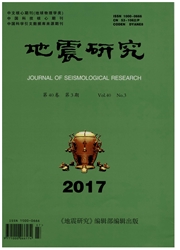

 中文摘要:
中文摘要:
采用2008年6月至2013年10月糯扎渡水库地震台网记录的6 300个地震,对水库蓄水前后的地震活动进行分析,发现库区蓄水后,地震频度与水位同步增长,地震活动显著增强,表明库区有水库诱发地震发生。蓄水前后的地震活动图像显示,澜沧江上景谷、双江交界处的小震活动增加最为显著,采用Hypodd双差相对定位方法对该震群进行了重新定位,定位后地震在空间上更为丛集,地震震源深度从0~20 km都有分布。该震群发生在窝拖寨断裂上,该断裂历史上曾发生过5.3级地震,因此分析认为,该震群的发生时间虽与水位相关,但可能是触发了构造地震,所以震源深度显现的是构造活动的特征。
 英文摘要:
英文摘要:
Using 6 300 earthquakes recorded by Nuozhadu Reservoir Seismic Network from Jun. , 2008 to Oct. 2013, we compared and analyzed the spatial distribution of seismic activity before and after the water storage of the Reservoir, and found that the seismic frequency increased simultaneously with water level, the activity of the earthquakes significantly enhanced after the water storage, which indicated that there occurred the reservoir induced earthquake in the reservoir area. The seismic activity diagram before and after the water storage showed that the activity of small earthquakes increased significantly in the boundary of Jianggu and Shuangjiang in Lancang River. We relocated the Jinggu-Shuangjiang small earthquake swarm by using the Hypodd double location method. The spatial distribution of earthquake centralized after relocation, and the focal depth distributed in 0 - 20 km. The earthquake swarm occurred at the Wotuozhai Fault where the M5.3 earthquake occurred in history. Although the occurrence time of the earthquake swarm had the relation with water level, they were the tectonic earthquake, which indicated the characteristic of the focal depth showed the tectonic activity.
 同期刊论文项目
同期刊论文项目
 同项目期刊论文
同项目期刊论文
 期刊信息
期刊信息
